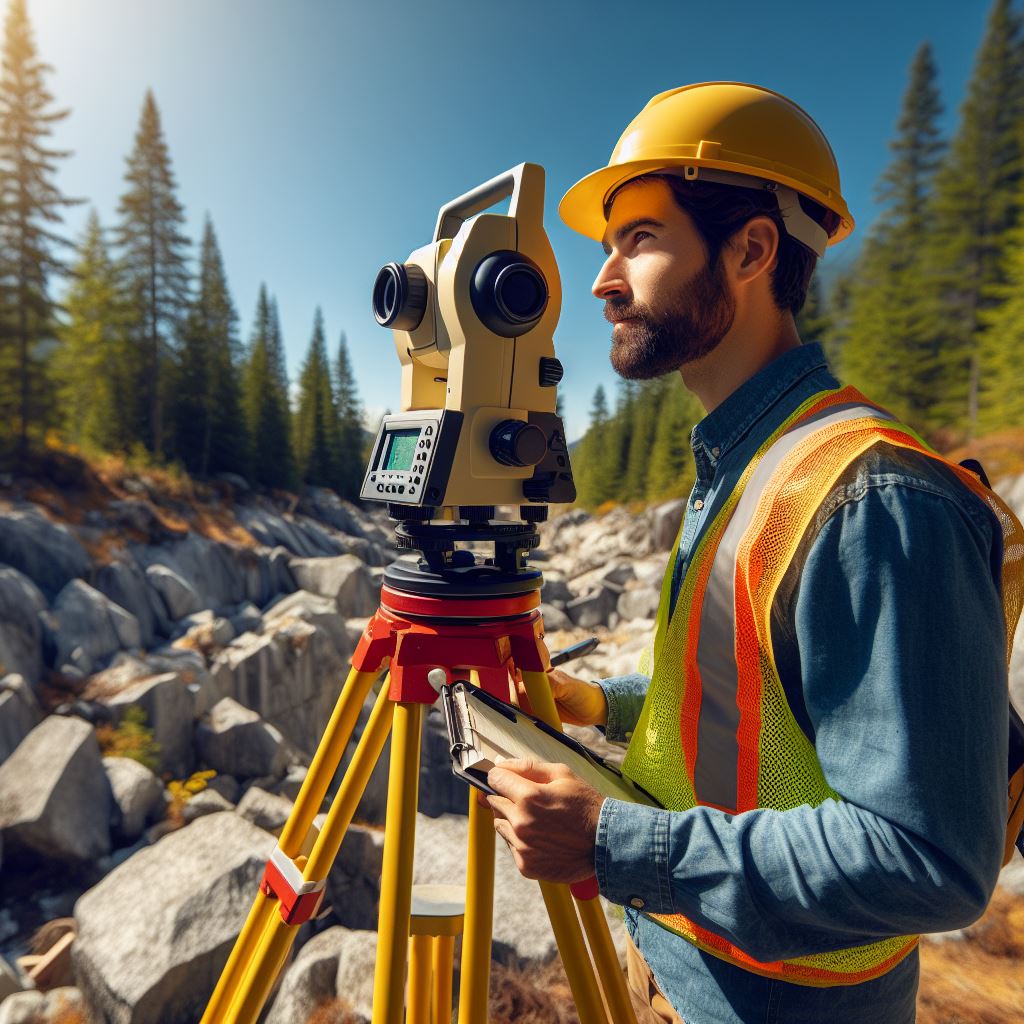Introduction
Surveying plays a crucial role in various industries, providing vital data for construction, mining, and infrastructure development.
Advancements in technology have revolutionized the field of surveying, making it more accurate, efficient, and accessible.
In this blog post, we will explore the future of surveying in Canada and the emerging technology trends that are shaping its landscape.
As we stand on the precipice of technological evolution, the future of surveying in Canada beckons with unprecedented promise and innovation.
In this compelling exploration, we delve into the dynamic landscape of surveying, navigating the currents of cutting-edge technology that are reshaping the industry.
From advanced geospatial tools to revolutionary data analytics, join us on a journey to unravel the Tech
Trends that will redefine the very essence of surveying in the Canadian context.
The horizon is ablaze with possibilities, and this exploration is your gateway to understanding the transformative forces shaping the future of surveying in the Great White North.
The Role of Technology in Surveying
Technology plays a crucial role in improving accuracy and efficiency in surveying.
By utilizing advanced tools and equipment, surveyors are able to collect and analyze data more effectively than ever before.
Importance of Technology in Improving Accuracy and Efficiency in Surveying
One of the main advantages of technology in surveying is its ability to enhance accuracy.
Traditional surveying methods, such as using tape measures and theodolites, are prone to human errors, which can lead to inaccurate measurements and results.
However, technology has significantly reduced these errors by providing automated and precise measurement tools.
Moreover, technology has increased the efficiency of surveying processes.
Previously, surveyors had to spend a considerable amount of time manually recording and organizing data.
With the advent of digital data collection tools, surveyors can now seamlessly collect, store, and analyze data, saving time and effort.
Overview of Traditional Surveying Methods and Their Limitations
Traditional surveying methods have been relied upon for centuries.
These methods typically involve the use of various instruments such as tape measures, theodolites, and total stations.
While these tools have served their purpose, they come with inherent limitations.
One major limitation of traditional surveying methods is their reliance on manual calculations.
Surveyors often have to perform complex calculations to determine angles, distances, and elevations, which introduces the risk of human error.
Additionally, these methods can be time-consuming, especially when dealing with large-scale projects.
Introduction to the Various Technological Advancements in Surveying Tools and Equipment
In recent years, significant advancements have been made in surveying technology, revolutionizing the industry.
These advancements have introduced numerous tools and equipment that have greatly improved the accuracy and efficiency of surveying processes.
One such advancement is the use of Global Navigation Satellite Systems (GNSS).
Unlock Your Career Potential
Visualize a clear path to success with our tailored Career Consulting service. Personalized insights in just 1-3 days.
Get StartedGNSS technology enables surveyors to accurately determine positions, distances, and elevations by utilizing signals from satellite constellations.
This technology has greatly reduced the need for manual measurements and calculations, resulting in increased accuracy and time savings.
Laser scanning technology has also revolutionized surveying practices.
Laser scanners can quickly capture detailed 3D data of landscapes, buildings, and structures, providing highly accurate representations.
The data obtained from laser scanning can be used for various applications such as creating digital terrain models and accurate as-built drawings.
Furthermore, the use of drones in surveying has gained significant popularity.
Drones equipped with high-resolution cameras and LiDAR sensors can capture aerial imagery and collect data over large areas in a short span of time.
This technology allows surveyors to quickly assess site conditions, monitor construction progress, and generate accurate topographic maps.
Overall, the future of surveying in Canada looks promising with the continued integration of technology.
The advancements in surveying tools and equipment have significantly improved accuracy, efficiency, and productivity in the industry.
As technology continues to evolve, surveyors can expect more innovative solutions that will further streamline their workflow, reduce costs, and enhance data accuracy.
Read: Rural vs Urban Surveying: A Canadian Perspective
Tech Trends in Surveying in Canada:
Adoption of GNSS (Global Navigation Satellite System) technology in surveying
GNSS technology provides numerous benefits and applications in land surveying.
GNSS is widely used in various sectors in Canada, including construction, transportation, and natural resource management.
The emergence of Unmanned Aerial Vehicles (UAVs) in surveying
UAVs offer advantages such as improved efficiency, cost-effectiveness, and enhanced data collection capabilities in surveying.
The use of UAVs in Canada is subject to specific regulations and challenges that need to be addressed for safe and effective operations.
Laser Scanning and LiDAR technology in surveying
Laser scanning and LiDAR technology provide precise and detailed data for topographic surveys, construction projects, and infrastructure development in Canada.
These technologies have revolutionized surveying by capturing accurate 3D data, reducing field time, and enhancing data visualization.
Utilization of Geographic Information Systems (GIS) in surveying
GIS plays a crucial role in managing and analyzing survey data, enabling better decision-making and planning.
Integration of GIS with other surveying technologies in Canada allows for comprehensive data analysis, visualization, and efficient project management.
Read: Canadian Surveyors: Their Role in Urban Planning
Delve into the Subject: Architects’ Role in Canadian Urban Design
Benefits and Challenges of Technological Advancements in Surveying
Enhanced accuracy and efficiency in data collection and analysis
The integration of advanced technologies in surveying has significantly improved the accuracy and efficiency of data collection and analysis processes.
Traditional surveying methods often involved manual measurements, which were prone to human errors.
However, with the adoption of modern surveying equipment such as GPS and laser scanning, data can now be collected with high precision.
These technological advancements allow surveyors to capture detailed information about the land or infrastructure being surveyed.
By utilizing GPS systems, surveyors can pinpoint exact coordinates, ensuring accurate representation and mapping of the surveyed area.
Furthermore, laser scanning technology enables the generation of highly precise 3D models, which can be used for various applications in engineering and construction industries.
With enhanced accuracy and efficiency, surveyors can now complete projects in a shorter period, reducing overall costs and improving productivity.
The availability of real-time data allows for immediate analysis and decision-making, minimizing project delays and ensuring optimal outcomes.
Increased safety for surveyors working in hazardous environments
Surveying often involves working in challenging and hazardous environments, such as construction sites, mines, or remote areas.
Technological advancements have introduced various tools and techniques that enhance the safety of surveyors in such conditions.
For example, drones equipped with LiDAR sensors can be used to collect data in inaccessible or dangerous terrains.
This eliminates the need for surveyors to physically enter hazardous areas, ensuring their safety.
Additionally, advanced imaging technology enables the identification of potential risks or hazards on-site, allowing surveyors to take proactive measures to mitigate them.
By reducing the exposure of surveyors to hazardous environments, technological advancements contribute to the overall well-being and job satisfaction of professionals in the field.
Potential cost savings and optimization of resources
Embracing technological advancements in surveying can lead to significant cost savings and optimization of resources.
Modern surveying tools and software enable surveyors to gather data more efficiently, eliminating the need for repetitive measurements or manual calculations.
By streamlining the data collection process, surveyors can optimize their resources, reducing the number of field visits and minimizing the overall time required for data collection.
This translates into cost savings in terms of labor, equipment, and transportation.
Furthermore, the integration of Geographic Information System (GIS) technology allows for effective data management and analysis.
This enables surveyors to identify patterns, trends, and correlations in the collected data, leading to informed decision-making and efficient resource allocation.
Technical challenges and skills required for surveyors to adapt to new technologies
While technological advancements offer numerous benefits to the field of surveying, they also present various technical challenges that surveyors need to overcome.
Adapting to new technologies requires a continuous learning process and the acquisition of new skills.
Surveyors need to stay up-to-date with the latest advancements in surveying equipment, software, and data processing techniques.
They must possess a solid understanding of both traditional surveying methods and emerging technologies to effectively adapt to changing industry demands.
Moreover, the integration of advanced technologies requires a higher level of technical expertise.
Surveyors need to be proficient in operating complex equipment, analyzing large datasets, and interpreting results accurately.
It is essential for surveyors to invest in continuous professional development and training to keep pace with the evolving field.
In general, technological advancements in surveying offer numerous benefits, including enhanced accuracy and efficiency in data collection and analysis, increased safety for surveyors, potential cost savings, and optimization of resources.
However, surveyors must be aware of the technical challenges associated with adopting new technologies and continuously upgrade their skills to stay competitive in the industry.
Read: Salary Trends for Surveyors in Canada (2024 Update)

Future Outlook and Potential Impacts
Predictions for the future of surveying in Canada
- Increased use of drones and unmanned aerial vehicles (UAVs) for surveying purposes.
- Adoption of 3D laser scanning for more accurate and detailed measurements.
- Integration of Geographic Information Systems (GIS) to enhance survey data analysis and mapping.
- Continued development of mobile and cloud-based surveying applications for improved efficiency and accessibility.
The potential impact of emerging technologies such as Artificial Intelligence (AI) and Machine Learning (ML) on surveying
The emergence of AI and ML technologies is expected to revolutionize the field of surveying in Canada.
- AI algorithms can analyze large volumes of survey data quickly and accurately, reducing human error.
- Machine Learning can identify patterns and trends in survey data, enabling more informed decision-making.
- AI-powered software can automate tasks, such as data processing and report generation, saving time and resources.
- ML algorithms can improve the accuracy and precision of survey measurements by learning from past data.
The potential integration of surveying technology with other disciplines like Virtual Reality (VR) and Augmented Reality (AR)
The integration of surveying technology with VR and AR has the potential to transform the way survey data is visualized and analyzed.
- VR can create immersive environments where surveyors can virtually explore the surveyed area in real-time.
- AR can overlay survey data onto the physical environment, providing real-time information during field surveys.
- VR and AR technologies can enhance collaboration and communication among surveying teams by visualizing data in a shared virtual space.
- VR and AR can improve stakeholder engagement by providing interactive and intuitive visualizations of survey results.
In a nutshell, the future of surveying in Canada holds immense potential due to emerging technologies and the integration with other disciplines.
Predictions indicate the increased use of drones, 3D laser scanning, and GIS. The impact of AI and ML is expected to streamline data analysis and automate tasks.
Additionally, VR and AR technologies will provide new ways of visualizing and analyzing survey data.
As the field of surveying continues to evolve, professionals in Canada should embrace these tech trends to enhance their surveying capabilities and deliver superior results.
Read: Top Canadian Universities for Aspiring Surveyors
Conclusion
The future of surveying in Canada is heavily influenced by technological advancements.
By embracing new tech trends, surveyors can improve accuracy, efficiency, and data analysis.
Staying updated with these advancements is crucial for professionals to thrive in the industry.
It is important to recognize the potential benefits that technology can bring to surveying and to continuously seek knowledge about these advancements.
Engaging in discussions with peers and seeking further information can help professionals stay ahead and adapt to the changing landscape of surveying in Canada.
By leveraging technology, surveyors can enhance their skills, expand their capabilities, and provide better solutions to clients.
Embracing these tech trends will not only drive the future of surveying but also shape the industry in Canada for years to come.




